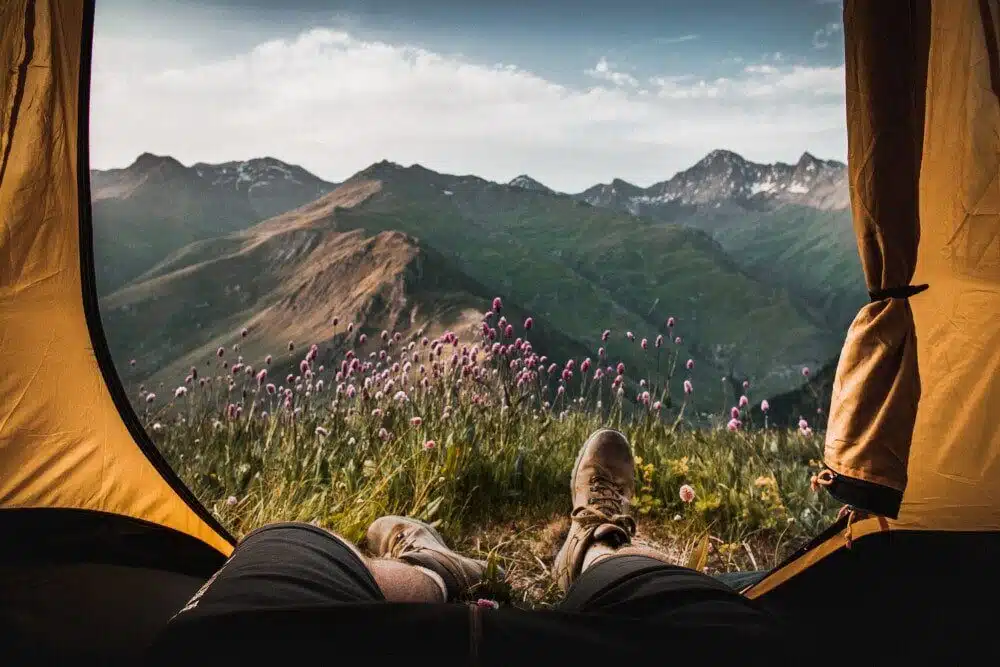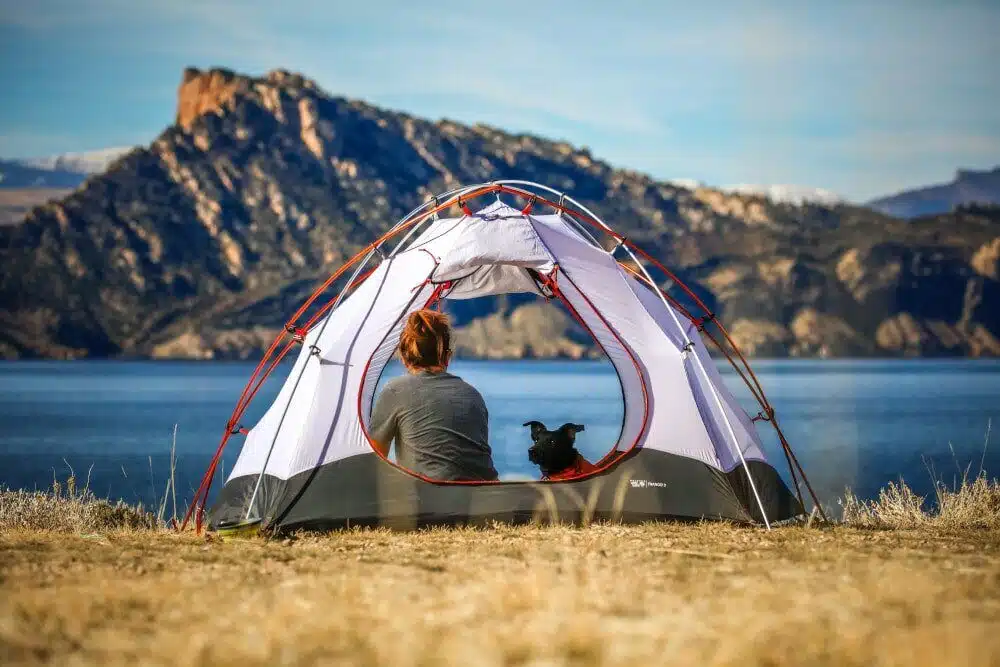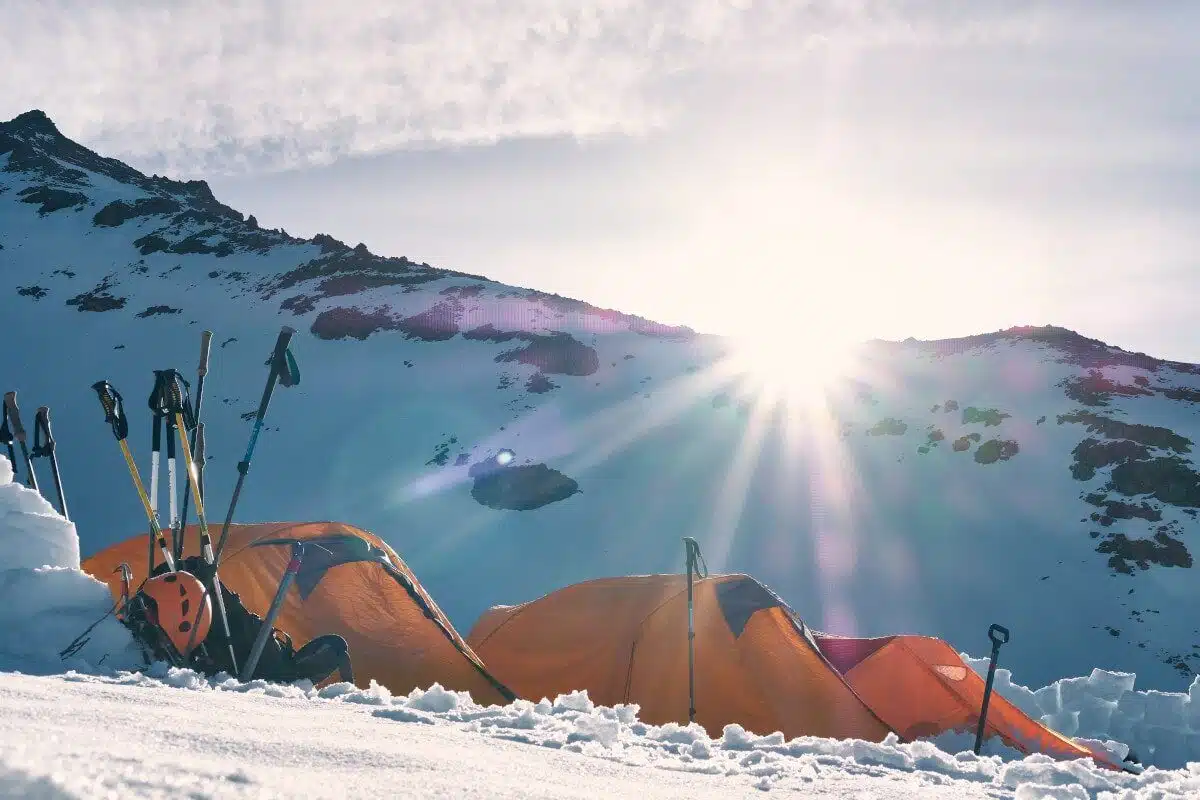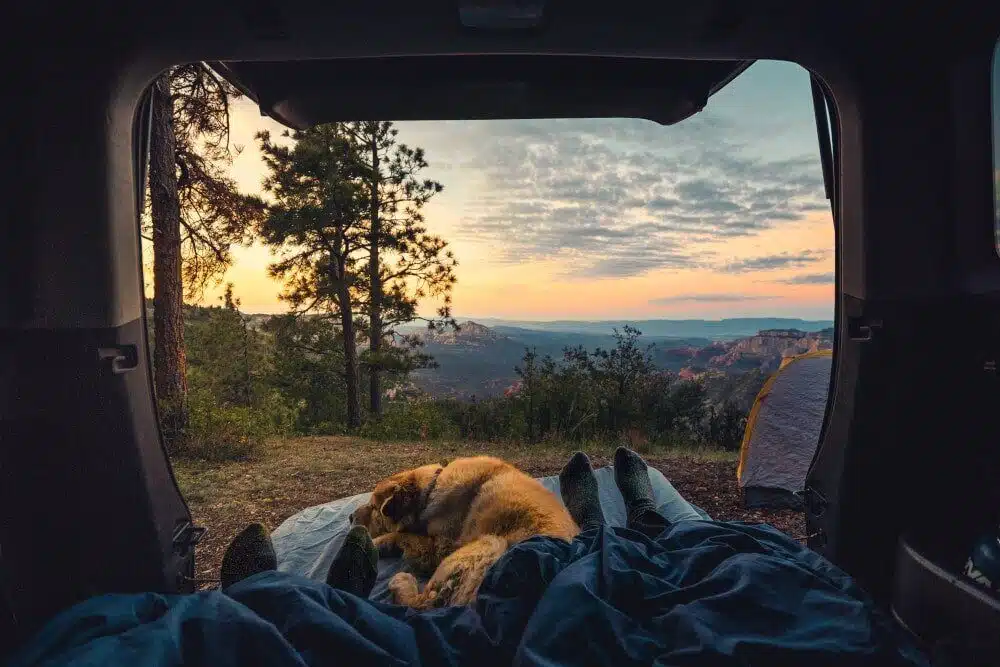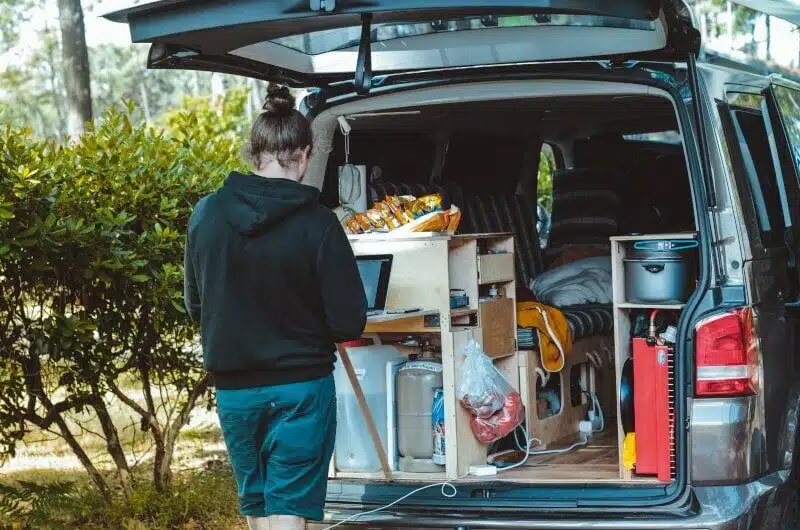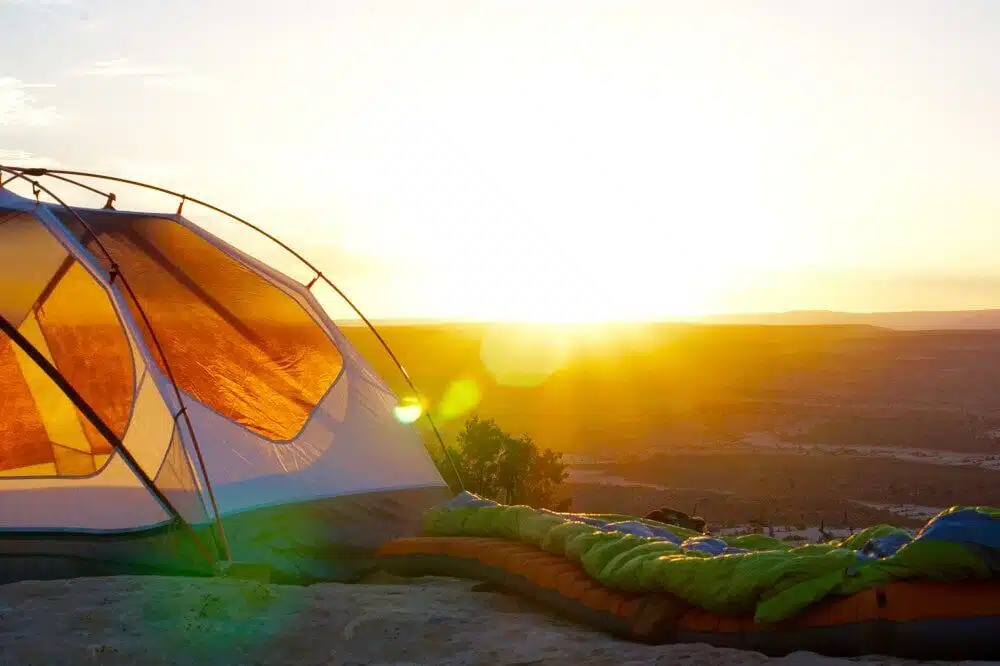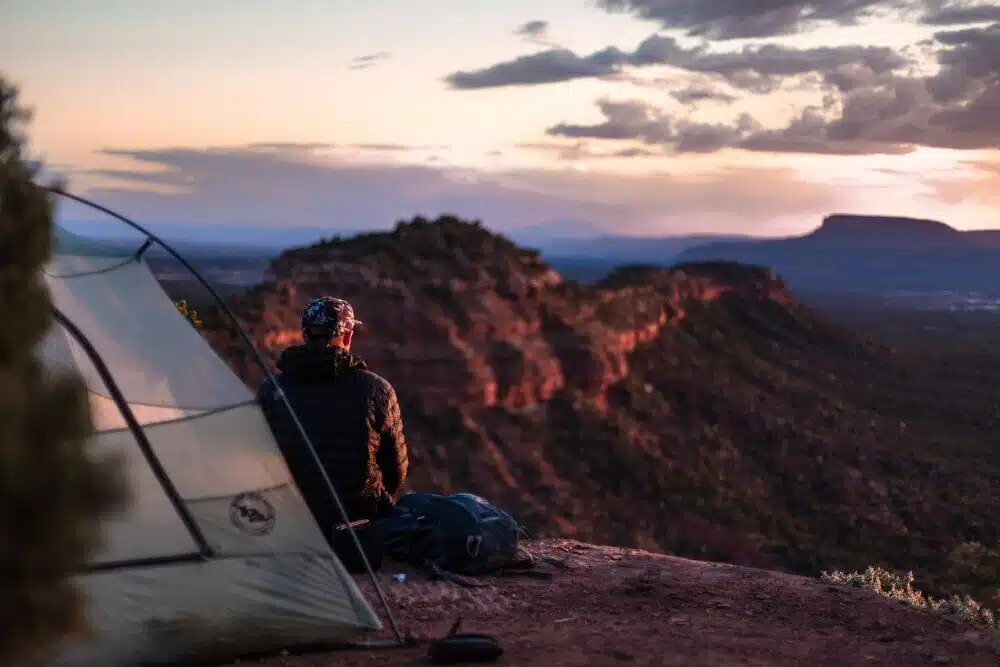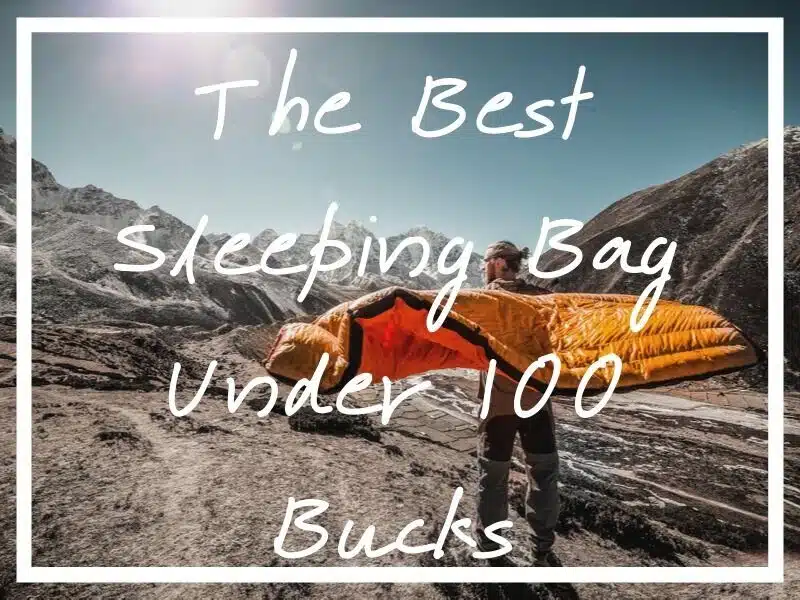
I hope you find value in this buying guide to the best backpacking sleeping bag under 100 dollars!
Sleeping bags are essential bits of kits for anybody going camping, hiking (overnight), or backpacking.
They create a barrier between you and the ground, protect you from the cold, and enable a good night’s sleep when you’re out and about.
Unfortunately, they can also be expensive!
Some of the best quality sleeping bags cost hundreds of dollars- a price tag that’s excessive when you don’t need (or want) top of the line gear.
Thankfully, you don’t have to pay through the nose for a decent sleeping bag nowadays. There are plenty of budget sleep bag options out there that’ll do the job just fine!
I’ve found and reviewed 8 of the best backpacking sleeping bags under $100 that’d be ideal for casual use in the great outdoors!
Looking to buy the best backpacking sleeping bag under 100 bucks possible? Keep reading!
[Last Updated: January 2021]
Heads up, this post contains affiliate links.
The Best Sleeping Bag Under 100 – Summary Table
Shape: Rectangle
Temp: 41-59°F
Weight: 4.4lbs (2.1kgs)
Material: Polyester
Rating: 4.5/5
Price:
Shape: Mummy
Temp: 14°F
Weight: 3.6lb (1.6kg)
Material: Polyester
Rating: 4.4/5
Price:
Shape: Rectangle
Temp: 0°F
Weight: 5lbs (2.3kg)
Material: Synth Taffeta
Rating: 4.7/5
Price:
Shape: Mummy
Temp: 30°F
Weight: 4lbs (1.8kgs)
Material: Down + Synth
Rating: 4.4/5
Price:
Shape: Mummy Bag
Temp: 20°F
Weight: 3.8lbs (1.7kgs)
Material: Polyester
Rating: 4.5/5
Price:
Shape: Mummy
Temp: 0°F
Weight: 5.2lb (2.4kg)
Material: Polyester
Rating: 4.6/5
Price:
Shape: Rectangle
Temp: 32°F
Weight: 5.7lbs (2.6kgs)
Material: Polyester
Rating: 4.5/5
Price:
Shape: Mummy Bag
Temp: 15°F
Weight: 2.6lb (1.2kg)
Material: Goose Down
Rating: 4.5/5
Price:
There are certain things to think about before buying your budget sleeping bag.
How to Choose the Best Backpacking Sleeping Bag
Here are 6 things to keep in mind to help you choose the best backpacking sleeping bag possible.
1. Your Location
The place you’re heading to should be a primary consideration when selecting a sleeping bag.
Ask yourself:
- What time of year are you going?
- Will the country be hot or cold?
- Is the weather likely to change a lot?
- Is it likely to rain frequently?
- Will your sleeping bag possibly get wet as well?
Certain sleeping bags are more suited to particular weather. The best budget sleeping bag for you will depend on what you expect to experience.
There’s nothing worse than being too hot or too cold at night.
Warmer climates require lighter bags; the opposite’s true for colder climes.
Unfortunately, the extra size and weight of cold weather sleeping bags tend to make them more expensive.
Thankfully, you can still find appropriate bags without overspending. I’ve included a pick for the best cold weather sleeping bag under $100 later in the post.
2. Your Plans
Your choice of cheap sleeping bag should take into account your plans too.
For instance, with one backpack and numerous countries on the itinerary, space is of paramount importance.
You’ll need the smallest and lightest sleeping bag possible.
By contrast, if you’re travelling by car, with no restrictions on space or weight, a larger and heavier sleeping bag would be fine.
Likewise, will you be spending time at altitude? What’s the coldest temperature you’ll face? How many opportunities will you have to use the sleeping bag?
The best sleeping bag for you will depend heavily on what you need it for. Be sure to put some thought into that before making a purchase.
3. The Bag’s Size and Weight
Size and weight of the sleeping bag are crucial considerations.
How much space will you have? How much weight do you want to carry? What’s the best size to weight to heat ratio you can find?
In other words:
What’s the smallest and lightest bag available that keeps you as warm as possible?
If space is an issue, having a compression sack for your sleeping bag is probably essential.
This is a bag that goes around the sleeping bag, with cords and ties that allow you to compress it into the smallest size possible.
Finding the best backpacking sleeping bag means you can sleep in beautiful spots like this! Just make sure you get the right temperature rating!
4. The Sleeping Bag’s Temperature Rating
The temperature rating is key to choosing a sleeping bag.
But what is temperature rating?
According to REI:
A sleeping bag’s temperature rating identifies the lowest temperature at which a bag is intended to keep the average sleeper warm. When a bag is described as a “20-degree bag,” it means that most users should remain comfortable if the air temperature drops no lower than 20°F. These ratings assume that the sleeper is wearing a layer of long underwear and using a sleeping pad under the bag.
You’ll need to find a temperature rating that’ll suit both you and the temperature of the places you’ll be sleeping.
By ‘suiting you’ I’m referring to the fact that everyone sleeps differently.
In technical sleeping bag lingo, you’re either referred to as a ‘cold sleeper’ or a ‘warm sleeper’.
The category you fit depends on how hot you typically get at night. Warm sleepers are your stereotypical human radiators; cold sleepers are, well, not.
Typically, temperature ratings are between 15 – 50°F (-9 to +10°C).
However, as people heat differently, temperature ratings are only ever intended as a guide.
Top tip for choosing the best sleeping bag for backpacking: Choose a sleeping bag suited to slightly colder temperatures to those you’re likely to encounter. If you’re too warm, simply air the bag by cracking the zip open a little.
5. The Budget Sleeping Bag Insulation
Another important consideration of choosing a sleeping bag is the type of insulation used inside. There are typically 2 types: synthetic (usually polyester) and down (duck or goose).
Here are the pros and cons of each:
Synthetic Insulation
Pros of Synthetic Insulation:
- Typically cheaper
- Retains warmth when wet
- Dries much quicker than down
- Good for damp climates
Cons of Synthetic Insulation:
- Worse warmth to weight ratio
- Typically larger when compressed
- Insulating power decreases each time it is repacked
Down Insulation
Pros of Down Insulation:
- Higher quality insulation
- Lighter in weight
- Compresses smaller without losing insulation when repacked
- Better insulation for more extreme cold
- Possible water treated down to make water-resistant
Cons of Down Insulation:
- More expensive than synthetic
- Ethical issues (a byproduct of the meat industry- more on this below)
- Loses heat when wet
- Harder to dry versus synthetic insulation
6. Size and Shape to Best Fit Your Body
A final consideration when choosing your sleeping bag should be its size and shape in relation to your body.
The shape is important because of how a sleeping bag works.
Remember, you are the heat source for your sleeping bag!
Essentially, your body creates ‘dead-air’ (air that doesn’t circulate) that heats up inside. The bag then creates a barrier between this heat and the ground, stopping it from leaving.
With more space, there’s more to heat and also more chance of the air circulating (i.e. the air isn’t ‘dead’).
This all means that it is important to find a bag that’s a good fit for your body.
There are two main types: the mummy bag or rectangle bag. Here are the pros and cons of both.
Pros of the Mummy Sleeping Bag:
- The shape is form fitting, meaning it is tapered to the body. This keeps warm air close, without leaving space for it to cool down.
- Generally smaller in size and lighter weight
- Smaller size means they compress more easily and into smaller final form
- Apparently more suited to backpacking trips
Cons of the Mummy Sleeping Bag:
- Tapered shape can feel restrictive when inside
- Less space to move around inside
- Less suitable to people with larger frames
Pros of the Rectangle Sleeping Bag:
- Better for larger people
- Less restrictive than the mummy shape
- More room and space to move around inside
Cons of the Rectangle Sleeping Bag:
- More air can circulate, so less suited for colder climates
- Generally larger and heavier in size
- Don’t compress as easily
FYI: it is also possible to find semi-rectangular sleeping bags, which are good if you want more space while remaining tapered, lightweight and compact.
And finally, there are two-person sleeping bags (also known as ‘double wide’), which (as the name suggests) are designed to sleep two people inside.
As you can imagine, these are much larger in size, but great if you are travelling with a friend/loved one and have the means to easily transport them.
When you’re camping in the snow, you need a budget sleeping bag with a good enough temperature rating for the job!
The Best Sleeping Bag Under 100: Rating Types
I never knew there was so much to know about sleeping bags.
Turns out there’s a whole bunch of rating systems used. The ones below seem to be the most common- at least that I came across in my research.
A) Season ratings
Season ratings refer to the number of seasons of the year in which the sleeping bag is most suitable. The range, confusingly (as there are only 4 seasons), is from 1 to 5.
- 1 season: these sleeping bags are suited exclusively to the hot months of summer
- 2 seasons: these sleeping bags are suited to use between late spring & early autumn.
- 3 seasons: these sleeping bags are suited to use between early spring & late autumn.
- 4 seasons: these sleeping bags are suited exclusively to the winter months (temperatures below 0). These are thick and often down insulated- see below.
- 5 seasons: These sleeping bags are also known as ‘expedition bags’ and are designed for high altitude mountain ascents and extreme cold.
B) EN tested tag ratings
The EN tested tag is found on many three-season sleeping bags and stands for European Norm testing protocol.
EN testing is generally recognised as the most objective and dependable temperature rating. Unfortunately, not all bags use it.
But where a sleeping bag has been EN tested, you’ll see two further ratings:
- Comfort rating: this is the lowest temperature that a bag will keep the average ‘cold sleeper’ comfortable.
- Lower limit rating: this is the lowest temperature that a bag will keep the average ‘warm sleeper’ comfortable.
Again, despite their greater reliability, these EN tag ratings are still only intended as a guide.
Check out the following features of the best sleeping bags for backpacking.
Features to Consider When Choosing the Best Budget Sleeping Bag
1) Hood
Having a hood on the sleeping bag is highly recommended for colder climates.
As your head releases a huge amount of heat, having it covered at night should be a priority in colder climes.
2) Left or Right-Handed Zip
Sleeping bags sometimes offer the choice of either a left or right-handed zipper.
This shouldn’t necessarily be a deciding factor, but it can definitely be awkward to unzip your bag with the wrong hand.
And remember, every second counts when you’re bursting for the loo at 6 am in the morning…
3) Roll Mat Sleeve
Some sleeping bags are now being designed with a slot on the underside for a roll mat to go inside.
This is a cool feature that puts an end to the annoyance of rolling off your mat onto the cold earth below!
However, I’ve seen mixed reviews of these, so it might be worth doing so further research before making the call.
4) A Stash Pocket for Valuables
Another nice feature you sometimes see is a stash pocket- usually somewhere on the inside of the sleeping bag.
It just means that your valuables are kept close to hand and you know where they are at night!
5) Pillow pocket- put clothes etc to make a pillow.
And finally, some sleeping bags now have a pocket in the hood for a pillow too.
Where a pillow is often a deal-breaker in the bid for sleep when camping, having one there all the time is handy.
It doesn’t need to be a proper backpacking pillow though- you could just roll up your clothes inside instead.
Love backpacking in the great outdoors? These posts might be of interest!
Get ready for 8 top options for your next budget backpacking sleeping bag.
The Best Backpacking Sleeping Bags Under $100- Reviews
Finally, on to the main purpose of the post! Here are the best backpacking sleeping bags under 100 bucks.
1. Norsens Ultralight 3 Season Envelope Sleeping Bag
Key Features
- Rectangle/envelope
- 3 season
- 41-59°F
- 12 month warranty
- Water repellent
- Machine washable
- Draft tube
- Stuff sack included
Description
I see this Norsen’s sleeping bag as a discount and compact version of the Lakeman above.
The style and design’s pretty much the same. However, it presses down into roughly the same size as a drink’s bottle! You’ll spend about 20 bucks less on the Norsen too.
Just don’t expect to stay as warm in it.
This one’s better for warmer climates. Again, though, that’s totally reasonable given its size. You’ll never find a sleeping bag at that price point and size that’ll see you through extreme temperatures.
Overall, this is a top quality, simple sleeping bag.
It’d be ideal for backpackers with limited space.
Pros
- Extra long
- Packs up small
- 12 months warranty
- Super cheap
Cons
- Less suited to cold weather
2. Teton Sports Celsius XL
Key Features
- Rectangle/envelope
- 0°F
- XL
- Mummy Hood design
- Taffeta material
- Interior storage pocket
- Draft tube
- Stuff sack included
- Antisnag zippers
Description
Not going to lie, the Teton Sports Celsius is a bit of a beast.
Backpackers looking for ultralight solutions should look elsewhere on this list.
Apart from that, though, it’s hard to fault.
You’re looking at a well-made, high-quality sleeping bag.
Furthermore, the extra size and weight is the price you pay for its cold-weather capabilities. The Teton’s going to keep you warm and cozy at night.
It ticks almost all the other boxes you’d be looking for too: spacious, durable and good value for money.
Pros
- Good value for money
- Great in cold weather conditions
- Durable materials
- Well made
- Keep valuables safe
- Lots of space
Cons
- Pretty big and heavy
3. Kelty Tuck 22F Degree Mummy Sleeping Bag (Awesome Backpackers Sleeping Bag)
Key Features
- Mummy shape
- 20°F
- Polyester
- ThermaPro insulation
- Vented foot box
- Stuff sack included
Description
The Kelty Tuck 20°F (you can also buy versions with different temperature ratings to suit your needs) is my pick for the best backpackers sleeping bag on this list! It’s well-made, highly-rated, comes with a bunch of handy features, and has a good weight to warmth ratio too.
Kelty’s a well-respected brand in the industry too, meaning you can rely on this sleeping bag to leave you satisfied.
Personally, I’d struggle with the tapered design (I like to move around at night!), but it’d definitely keep you nice and snug at night. There’s also a vented foot box (aka it’s extra spacious and has a j-shaped zipper that lets you stick a foot out at night!) that’d increase ventilation on hot nights.
At almost 4lbs in weight, this isn’t the lightest backpacking sleeping bag under 100 that you’ll find. But it’s specially-designed ThermaPro materials will help you pack it away and retain warmth at the same time.
Last but not least, opt for the longer version and the Kelty Tuck claims to sleep someone up to 6’6” tall! Take that with a pinch of salt though. Be wary if you’re tall and heavier set as there were a few reports from people who found this budget sleeping bag too restrictive.
All told, you’re looking at another top backpacking sleeping bag under $100 that I’d rank pretty high up on this list overall.
Pros
- Quality materials
- Keep valuables safe in storage pocket
- Zipper draft tube for extra warmth
- Open vent means space for feet!
Cons
- Less suited to large individuals over 6ft
- Reports of lower zipper snagging
4. Wakeman Outdoors 32F Envelope Sleeping Bag
Key Features
- Rectangle/envelope
- 32°F
- Waterproof
- Anti-snag zippers
- Drawstring hood
- Cotton liner
- Stuff sack included
Description
Here’s another larger sleeping bag for backpackers heading to colder climes with the luxury of a bit more space.
Thankfully, the stuff sack will pack it down a bit smaller.
However, with a carry bag of 11” by 18”, you’ll still end up with a big old bag to carry.
As a result, I’d expect families, vanpackers and road trippers to get most value from the Lakeman. It’s another highly-rated, high-quality, and well-made sleeping bag.
At under 55 bucks it’s also incredible value for money.
The size also means there’s plenty of space for anybody who’s bigger boned. And I’d say it’s one of the best-looking sleeping bags on this list too.
If aesthetics and space are important to you, the Lakeman could be a good bet.
Pros
- Good water resistance
- Cheap
- Super spacious
Cons
- Pretty big and heavy
Half way there! Keep reading to see my suggestions for the best backpacking sleeping bag under 200 bucks, the best sleeping bag under 50 bucks, and the best cold weather sleeping under $100.
5. OmniCore Designs Multi Down (Best Lightweight Sleeping Bag Under 100)
Key Features
- Mummy
- Duck down and synthetic combo
- 30°F
- Draft tube, collars and baffles
- Water repellent
- Ripstop shell material
- 3D footbox
- Stuff sack included
Description
I’ve never seen a sleeping bag quite like the Omnicore.
It looks like a combo between a rectangle and mummy design. For that I reckon it’d be super comfortable! The 3D foot box means your feet aren’t constricted either- a nice touch.
The price is at the upper end of the spectrum too, but it’s still most-definitely a budget sleeping bag.
Another potential con I noted was the apparent lack of ‘face space’.
Sleeping bag’s can get a bit claustrophobic. With a small ‘window’ for your face, that might be more of a problem. I’ve not tested it though and might be completely wrong.
In every other way it seems like a quality choice.
I like the features it has, and the size/weight ratio’s pretty good too. It won’t be the warmest bag on this list, but it definitely won’t be the coldest.
For the quality involved, I’d say this is an absolute steal of a sleeping bag.
Pros
- Performs well in wet conditions
- High-quality durable materials
- Lots of space for feet
- Relatively small and lightweight
Cons
- Less suited to coldest temperatures
- Enough face space?
6. Coleman 0°F Mummy Sleeping Bag (Best Cold Weather Sleeping Bag Under $100)
Key Features
- Mummy
- 0°F
- Polyester
- Water repellent
- Thermolock Insulation
- Stuff sack included
Description
This is my pick for the best Coleman sleep bag under 100 bucks! And, looking at the raving reviews for it online, I’d say people agree!
It should keep you warm down to 0°F (though that’ll be pushing its capabilities) and is suited for all sizes of people. It comes with a sleek and updated design as well. Even better, this sleeping bag is from Coleman, which is a respected brand in the outdoor industry.
That means you can expect a quality product all-round (just as you can with these Coleman tents!).
It’s hard to fault the Coleman sleeping bag other than for the potential size and weight issues it could cause for ultralightweight backpackers.
The only other slight hiccup you could experience is if you’re particularly tall or big-boned. I read a couple of reviews saying it was a little tight.
In every other way, though, this sleeping bag seems like a top purchase.
Pros
- Durable materials
- Well-suited to cold weather
- Value for money
- Aesthetically pleasing
Cons
- Large packed size
- Fairly heavy
- Less suited to larger individuals
The Best Sleeping Bag Under 50 Bucks
7. Bessport Mummy Sleeping Bag Review (Best Mummy Sleeping Bag Under 100?)
Key Features
- Mummy
- 4 season
- Synthetic materials
- Water repellent
- Ripstop fabric
- Risk free purchase
- Stuff sack included
- Drawstring hood
- Storage pocket
Description
You’ll struggle to find a better 4-season sleeping bag than the Bessport.
The fact that it’s under 50 bucks blows my mind! From all accounts, it’s a winning option.
For one thing, the Bessport sleeping bag is small and light considering it’ll keep you warm throughout the year.
Throw the durable materials, helpful features, and suitability to all sizes of people into the mix, and it’s hard to find a fault.
It’s true that the packed size isn’t negligible though.
It’ll roll up (you can’t just cram it) into a 14.5” x 11” stuff sack. That’s pretty big (though smaller, and definitely lighter, than others on this list).
However, note that the stuff sack doesn’t have compression straps.
Buy a cheap pair of these separately and you’ll easily get that size down.
All told, the Bessport is undoubtedly one of the best-rated and top all-round bags here. That’s why I’d say it’s the best sleeping bag under 50 bucks.
With the compressions straps, I’d be tempted to buy it myself.
It’s a risk-free purchase as well. You can get a free replacement if there’s any issue (without sending your first one back in!), or a full refund.
Now that’s good customer service.
Pros
- Top rated online
- Great value for money
- 14°F survival rating = great for cold weather
- Storage pocket keep valuables safe
- Vented foot box
- Washable
- Free replacement!
Cons
- Relatively large packed size
The Best Backpacking Sleeping Bag Under 200 Bucks
8. Hyke & Byke Eolus Goose Down Sleeping Bag (Best Lightweight Sleeping Bag)
Key Features
- 3 Season
- Mummy shape
- Goose Down (ethically sourced)
- 15°F survival rating
- 30°F option available
- Drawstring hood
- Water repellent
- Lifetime warranty
- Stuff sack included
Description
Hyke & Byke’s a relatively new name in the outdoor industry.
However, they’ve made a name for themselves by selling products of the highest-quality at a budget price. That’s good news for us!
They’ve lived up to their reputation with the Hyke & Byke Eolus sleeping bag.
You’re getting a goose-down sleeping bag for well under 200 bucks. Had I not come across Hyke & Byke before, I’d say it was too good to be true.
For the extra money you do pay, you get a small, crazily lightweight sleeping bag. It compacts down to 6.5” x 8.5-9.5”. That’s insanely good news for anyone short on space (aka all backpackers).
You don’t sacrifice on durability either. This is a tough bag that’ll stand the test of time.
There’s a wide range of colors and designs to choose from too, meaning you can find one to suit your personality and style!
I’d say it’s well worth the extra expense.
Pros
- Durable materials
- Different colours to choose from!
- Range of sizes and weights
- Lightweight
- Suitable for extra cold weather
- Water repellent
- Great value for money
- Lots of space
Cons
- None that I can see
- Time to Find the Best Budget Sleeping Bag for You
- Sleeping bags can be essential kit for the road.
That brings to a close the best backpacking sleeping bags under 100 dollars. I hope you found one for your next adventure!
Buy the Best Backpacking Sleeping Bag Under 100 Dollars
There you have it: a buying guide to the best backpacking sleeping bag under 100 bucks.
Sleeping bags are often an essential part of anyone’s backpacking kit on the road. Campers, hikers, couch-surfers, dodgy hostel-goers and so on can all benefit from having one in their backpack. Even better, you don’t have to spend hundreds of dollars to get your hands on one.
Hopefully, this post has highlighted the best budget sleeping bag options to help you find one of your own!
Found a sleeping bag you like but no idea how to fit it inside or attach it to your backpack? Click here for a how-to guide that’ll help!
















